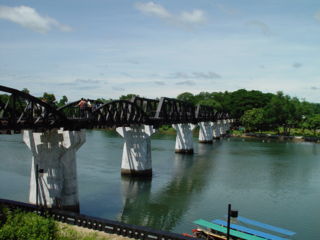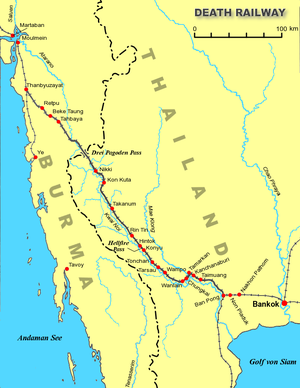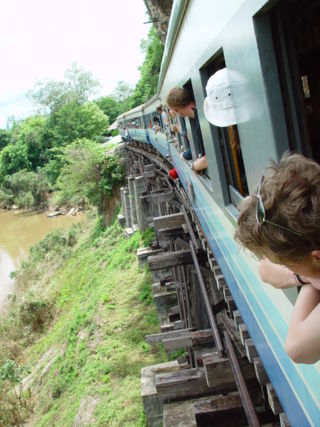Burma Railway
The Burma Railway, also known also as the Death Railway, the Thailand-Burma Railway and similar names, is a 415 km (258 mi) railway between Bangkok, Thailand and Rangoon, Burma (now Myanmar), built by the Imperial Japanese Army during World War II, to support its forces in the Burma campaign.
Forced labour was used in its construction. About 200,000 Asian labourers and 60,000 Allied prisoners of war (POWs) worked on the railway. Of these, around 100,000 Asian labourers and 16,000 Allied POWs died as a direct result of the project. The Allied dead were comprised of: 6,318 British, 4,377 United States, 2,815 Australians and 2,490 Dutch personnel.[1]
Contents
Planning
Japanese forces, supplies and equipment transported from East and North Asia to Burma by sea, through the Strait of Malacca, were vulnerable to attack by Allied submarines, and an alternative means of transport was needed. A railway connection between Thailand and Burma had been surveyed at the beginning of the 20th century by the British government of Burma, but the route — through hilly jungle terrain divided by many rivers, was considered too difficult to complete.
The Japanese started the project in June 1942, intending to connect Ban Pong with Thanbyuzayat, through the Three Pagoda Pass. Construction started at the Thai end on June 22, 1942 and in Burma at roughly the same time. Most railway materials, including tracks and sleepers, were carted from dismantled branches of the Federated States of Malaya Railways network.
The most famous part of the railway is probably Bridge 277 over the Khwae Yai River (Thai แควใหญ่, English "big tributary"). The river was originally known as the Mae Klong and was renamed Khwae Yai in 1960. It was immortalized by Pierre Boulle in his book and the film based on it: The Bridge on the River Kwai. The first wooden bridge over the Khwae Noi (Thai แควน้อย, English "small tributary") was finished in February 1943, followed by a concrete and steel bridge in June 1943. The Allies made several attempts to destroy the bridges, but only succeeded only in damaging them in their first attempts. On April 2, 1945, AZON bomber crews from the U.S. 458th Heavy Bombardment Group destroyed Bridge 277. After the war, two squarish central sections were made in Japan to repair the bridge, and were donated to Thailand.
On October 17, 1943, the two lines met about 18 km south of the Three Pagoda Pass at Konkuita (Kaeng Khoi Tha), Songklaburi district, Kanchanaburi). While most of the POWs were then transferred to Japan, those left to maintain the line still suffered from the appalling living conditions as well as Allied air raids.
Conditions for those who built the line
The living and working conditions on the railway were horrific. About 25% of the POW workers died because of overwork, malnutrition, and diseases like cholera, malaria, and dysentery. The death rate of the Asian workers was even higher; the number who died is unknown, as the Japanese did not count them. The estimated total number of those who perished during the construction is about 100,000-170,000.
POWs and Asian workers were also used to build the Kra Isthmus Railway from Chumphon to Kra Buri, and the Sumatra or Palembang Railway from Pakanbaroe to Moeara.
The construction of the Burma Railway is only one of many major war crimes committed by Japan in Asia during the war. It is regarded as a major event in the "Asian Holocaust", during which millions of civilians and POWs were killed by Japanese personnel.
After the war
After the war the railway was in too poor a state to be used for the civil Thai railway system, and needed heavy reconstruction. On June 24, 1949, the first part from Kanchanaburi to Nong Pladuk (Thai หนองปลาดุก) was finished; on April 1, 1952, the next section up to Wang Pho (Wangpo); and finally on July 1, 1958, up to Nam Tok (Thai น้ำตก, English waterfalls.) The portion of the railway still in use measures about 130 km. Beyond Nam Tok, the line has been abandoned. Steel rails have been removed for reuse in expanding the Bangsue Railway Yard, reinforcing the BKK - Banphachi double track, rehabilitating the track from Thung Song to Trang, and constructing both the Nong Pladuk - Suphanburi and Ban Thung Pho - Khirirat Nikhom branch lines. Parts of it have been converted into a walking trail. Since the 1990s there have been plans to rebuild the complete railway, but these plans have not yet come to fruition.
Cemeteries and memorials
The graves of the POWs who died were transferred from camp burial grounds and solitary sites along the railway to three war cemeteries after the war, except for Americans, who were repatriated. The main POW cemetery is in the city of Kanchanaburi, where 6,982 POWs are buried, mostly British, Australian and Dutch. A smaller cemetery a bit farther outside city is Chung Kai with 1,750 graves. At Thanbyuzayat in Myanmar there are some 3,800 burials of POWs who died on the Northern part of the line, to Nieke. The three cemeteries are maintained by the Commonwealth War Graves Commission.
There are several museums dedicated to those who lost their lives constructing the railway, the largest of which is at Hellfire Pass (north of the current terminus at Nam Tok), a cutting where the greatest number of lives were lost. There is also an Australian memorial at Hellfire Pass.
Two other museums are in Kanchanaburi, the Thailand-Burma Railway Museum (opened in March 2003), and the JEATH War Museum.
At the Khwae bridge there is a memorial plaque and a historic locomotive is on display.
A preserved section of line is at the National Memorial Arboretum, in England.
See also
- Lt Col. Sir Ernest Edward "Weary" Dunlop, Australian surgeon renowned for his leadership of POWs on the railway
- Frank Pantridge British physician and Cardiologist
- Philip Toosey Senior Allied Officer at the Bridge on the River Kwai
References
- The Japanese Thrust - Australia in the War of 1939-1945, Lionel Wigmore, Australian War Memorial, Canberra, 1957.
- River Kwai Railway: The Story of the Burma-Siam Railway by Clifford Kinvig (1992, Brassey’s London) ISBN 0-08-037344-5
- The Burma-Siam Railway and its Cemeteries, The Commonwealth War Graves Commission - Information Sheet, England, 2000.
External links
- Allied POWS under Japanese {reference only}
- 2/3rd Machine Gun Battalion AIF {Reference only}
- 2/18th Battalion AIF {reference only}
- Death Railway/death statistics {reference only}
- http://www.tourismthailand.org/destinationguide/list.aspx?provinceid=56&typeid=7
- http://www.ean.co.uk/Bygones/History/Article/WW2/Death_Railway/body_index.htm
- Prisoner of War FX Larkin NX43393 AIF — Detailed web site with documentation and photographs relating to the POW experiences of Frank Larkin in Malaya, Singapore, Thailand and Japan.
- http://www.POWs-of-Japan.net — Articles on the Australian medical personnel working on the railway. Also sketches by POWs.
- The Will to Live, by Len (Snowie) Baynes, a first-hand account of working on the Railway.
- Kanchanaburi War Cemetery CWGC for reference only
- Kanchanaburi Memorial CWGC for reference only
- Chungkai War Cemetery CWGC for reference only
- Thanbyuzayat War Cemetery CWGC for reference only
de:Death Railway nl:Dodenspoorlijn ja:泰緬鉄道 pl:Kolej Śmierci th:ทางรถไฟสายมรณะ
- ↑ Wigmore, p. 588)



